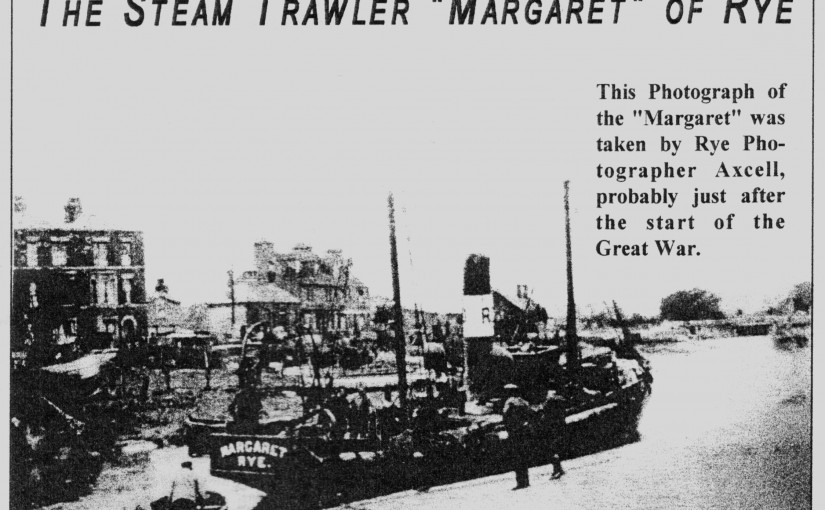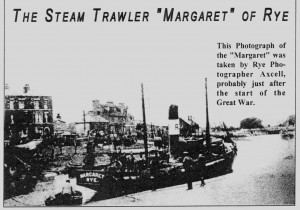Six Brave Rye Fshermen Killed in Wartime Tragedy
There was only one survivor when the Rye Trawler ‘Margaret’ was blown to pieces by an enemy mine as they fished in the bay they knew so well.
The ‘Margaret’ owned by Alderman W. E. Colebrooke J.P., slipped her moorings in the Strand and made her way down the Rother on the morning tide on that fateful day just before Christmas in war torn 1916. It was Sunday 17th. December and the seven strong crew under the Captaincy of James (Cockey) Foord joined other Rye trawlers in the fishing grounds which were continuously swept for mines by Royal Navy minesweepers.
At this critical period of the War, when German submarines were making great inroads into food imports, the catch of fish became a crucial factor in efforts to feed the nation. It was important for every boat to work as many hours as was humanly possible. Rye fishermen played their part to the full, risking their lives every time they cast their nets.
Their Thoughts Would Have Been on Christmas
As those seven brave men dragged their trawl along the ocean bed they would probably have been thinking of Christmas with their families. All were married men save for young Tom (Jeddic) Apps, a mere boy of fourteen, who had only just been taken on as crew. The six older men had a total of twenty-three children waiting at home for them, children whose every thought must have been concentrated on the Yuletide season Just around the corner and what surprises would be in store for them on this, the most important day in their calendar. Sadly, the surprise they were to receive would be the loss of their fathers and all that implied for this Christmas and many Christmases to come.
The steam winch on the ‘Margaret’ strained as it pulled up the trawl. The story is now taken up by the words of young Tom Apps as told to, and remembered by, Robert Hollands with whom he worked many years later.
“One of the men shouted that there was a mine in the net. I looked over the side and saw a circular mine with pins sticking out. The men were determined to cut it out to save the net rather than to let the net go. They told me to get behind the wheelhouse and get down as low as I could. There was a lot of shouting as they tried to cut the net and release the mine, keeping it away from the side of the vessel.”
Then it exploded.
“I was blown into the sea. I was very dazed but I could swim well and even despite the fact I was wearing a heavy sweater I managed to stay afloat. I kicked off my sea boots and began looking around for the others. All I saw were a few pieces of wreckage, there were no signs of any of the others. I swam around for about three hours until I was spotted by a Minesweeper which picked me out of the sea and took me to Dover. Mr. & Mrs. Colebrooke collected me from Dover and brought me home to Rye.”
Was it an Arm Mine?
Robert Hollands, a long time Rye fishermen in later life, and one with the experience of trawling up no less than eight mines in his peacetime fishing career, thinks that the ‘pin mine’ as described by Tom Apps may well have been a German ‘arm mine’. This type of mine, which explodes when a long arm of metal comes in contact with the side of a ship and the ‘pins’ act as treads rolling along the side of the vessel and screwing in a pin which breaks the glass detonator and sets off the charge. A mine of this type could have been known to the fishermen and they may well have thought they could cut it out of their net without setting it off, knowing the mechanics of the thing. Nets were very costly and to lose their trawl would have been a major setback. It could be they set the risk against losing their trawl and decided to take that risk. The fact that they sent the boy behind the wheelhouse supports this idea. If they had just released the winch and let the mine drift away from the boat there would have been no need for him to take cover.
This account from the lips of Tom Apps and a report of the damage to the boat by a diver who visited the wreck about twenty years ago discounts the idea, put about locally, that it was not a mine but the boiler which blew the vessel to bits. This theory seems to have emanated from the fact that other boats fishing nearby, did not hear the explosion.
News Reaches Rye Next Day
News of the disaster did not reach Rye until the day after the tragedy occurred. It swiftly spread throughout the town, creating a gloom that overhung not only the homes of the families of the victims but over the whole town. Skipper James Foord left a wife and six children. His wife was the daughter of Jack Berry, a well known Hastings fisherman.
The other men to lose their lives were, George (Sinbad) Boreham brother of Fred Boreham the well known Rye footballer, brothers James and John Wider, Robert Eldridge and Engineer Frank Martin.
The Mayor’s Appeal
The Mayor of Rye, Councilior G. Ellis J.P. immediately launched an appeal fund on behalf of the families to help with their grief and give practical help for the loss of the six precious lives.
In Rye Cemetery, between the two chapels, there is a memorial to these brave men who took on not only the elements but an even more deadly hazard in the form of a weapon made to destroy.
This story was compiled from details provided by June Foord who’s great uncle it was that Captained the ‘Margaret’ from Robert Hollands who worked with survivor Tom Apps and Clifford Jordan, a relative of James and John Hilder, the brothers who lost their lives on the ‘Margaret’
“Rye’s Own” December 2000
All articles, photographs and drawings on this web site are World Copyright Protected. No reproduction for publication without prior arrangement. © World Copyright 2015 Cinque Ports Magazines Rye Ltd., Guinea Hall Lodge Sellindge TN25 6EG

